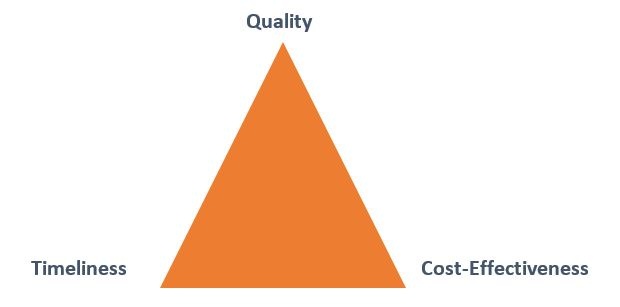Globalization, increased transparency of business activity, pervasive media coverage, and the growing complexity of business and business relationships have increased the ethics and compliance risks for organizations. There is greater likelihood of wrongdoing being exposed by the media, watchdog groups or government agencies or through a firm's internal systems. Illegal or unethical acts can be done intentionally by people of bad character or unintentionally by people who made decisions without full knowledge of what they were doing. The damage to a firm's reputation and the huge costs associated with fines and litigation can destroy a company. Therefore, managing for legal and ethical excellence has emerged as a critical as well as morally imperative function for all organizations.
How to Monitor and Manage Legal and Ethical Issues
Topics: Laws & Regulations, Ethics, Performance Management/Measurement
Outsourcing has become a keystone of major business operations to the point that it’s almost a given that large companies will move certain expensive business processes and labor-intensive activities to a third-party. Is this always the best option?
Topics: Internal Audit, Supply Chain, Vendor Management, Performance Management/Measurement, Outsourcing/Co-sourcing/Shared Services, Accounts Payable & Purchasing
Technology has greatly expanded the methods of creating, editing, maintaining, transmitting and retrieving records. From creation to disposition, records in electronic recordkeeping systems may now utilize a variety of media. An example of an electronic recordkeeping system is one in which a personal computer generates the original records, which are subsequently stored on a secondary electronic resource. While paper copies of the electronic records may be printed for distribution, the original records are transferred electronically.
Topics: Fraud, Risk Assessment, IT Risk, Strategic Risk, Document Retention, Performance Management/Measurement
Performance is defined as the throughput of business transactions compared to user needs, expectations or requirements. IT performance risk is the risk that a company’s IT infrastructure will be unable to perform at required levels due to inferior internal operating practices, technology and/or external relationships that threaten the demand for the organization's products or services.
Topics: IT Audit, IT Infrastructure, IT Risk, Change Management, Performance Management/Measurement
The 3 Components of a Successful Systems Design
What is design risk? To “design” is to create, fashion, execute or construct according to plan. The term design as used here refers to the entire scope of a project. A business system design is a collection of design documents and supporting materials which define the system functionality that supports one or more business processes and in the process, creates, retrieves, updates and deletes data.
Topics: IT Audit, IT Governance, IT Infrastructure, IT Strategy, IT Risk, IT Controls, Performance Management/Measurement
How to Build an Effective Business Process
Key Performance Measures Improving the Process
An effective business process is built on a set of well-defined and clearly-stated business objectives. These key objectives articulate the ideal performance results that the company expects from that process. To monitor a business process so that it stays focused on reaching the key objectives, the company chooses appropriate performance measures. In fact, careful selection of the performance measures takes a company a long way toward improving a business process. Thus, to build and then continually improve an effective business process, a company establishes:
Topics: Laws & Regulations, Accounting/Finance, Financial Reporting, Performance Management/Measurement
How Does Opportunity Risk Apply to Financial Business Processes?
Opportunity risk occurs whenever there’s a possibility that a better opportunity may become available after having committed to an irreversible decision.
We all experience opportunity risk at its most basic level several times a week. For example, imagine you have enough cash on you for lunch in a new town and you’re trying to decide between two restaurants you’ve never tried. What if you spend your time and money on the first option and it’s terrible? Or even maybe it’s not terrible, but the second option is just so much better?
Topics: Risk Assessment, Strategic Risk, Performance Management/Measurement, Budgeting, Cost Management
How Can Human Resource Risk Be Managed?
“All of the blame and none of the praise”
This was how one Human Resource professional described their job in a forum on tech recruiting recently. Human Resources (HR) can be a bit of a mine field full of potential hazards and risks while searching for that perfect candidate to fill a company’s needs.
Topics: Laws & Regulations, Human Resources, Risk Assessment, Strategic Risk, Performance Management/Measurement
How To Minimize Customer Fraud Risk
Fraud is the intentional perversion of truth in order to induce another to part with something of value or to surrender a legal right. In the business community, the ultimate goal of fraud is to gain money. There are numerous frauds within the business world.
Topics: Fraud, Ethics, Risk Assessment, Strategic Risk, Performance Management/Measurement, Customer Satisfaction
What is Process Accounts Receivable, Credit and Collections?
In recent blog posts, we’ve discussed KPIs for various processes and even gave a concise description of what they are (see Guide to Managing Mergers and Acquisitions KPIs). In this post, we’ll be looking at KPIs again and this time it’s for Accounts Receivable (AR), Credit and Collections and we have a great document on KnowledgeLeader that goes more in-depth.
Topics: Accounting/Finance, Accounts Receivable, Cash & Treasury, Performance Management/Measurement, Credit & Collections
Add a Comment:













